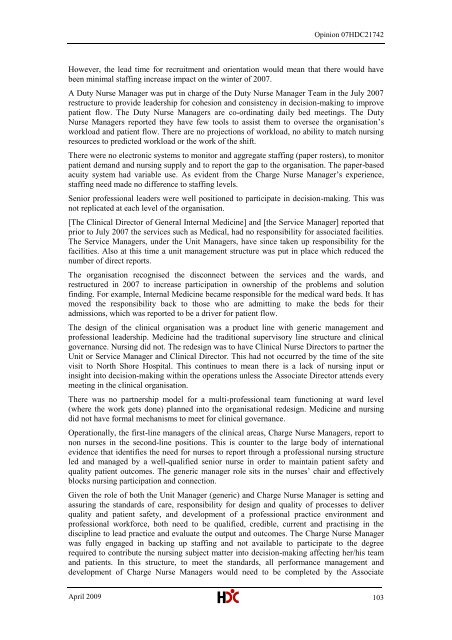North Shore Hospital report - New Zealand Doctor
North Shore Hospital report - New Zealand Doctor
North Shore Hospital report - New Zealand Doctor
Create successful ePaper yourself
Turn your PDF publications into a flip-book with our unique Google optimized e-Paper software.
Opinion 07HDC21742However, the lead time for recruitment and orientation would mean that there would havebeen minimal staffing increase impact on the winter of 2007.A Duty Nurse Manager was put in charge of the Duty Nurse Manager Team in the July 2007restructure to provide leadership for cohesion and consistency in decision-making to improvepatient flow. The Duty Nurse Managers are co-ordinating daily bed meetings. The DutyNurse Managers <strong>report</strong>ed they have few tools to assist them to oversee the organisation‘sworkload and patient flow. There are no projections of workload, no ability to match nursingresources to predicted workload or the work of the shift.There were no electronic systems to monitor and aggregate staffing (paper rosters), to monitorpatient demand and nursing supply and to <strong>report</strong> the gap to the organisation. The paper-basedacuity system had variable use. As evident from the Charge Nurse Manager‘s experience,staffing need made no difference to staffing levels.Senior professional leaders were well positioned to participate in decision-making. This wasnot replicated at each level of the organisation.[The Clinical Director of General Internal Medicine] and [the Service Manager] <strong>report</strong>ed thatprior to July 2007 the services such as Medical, had no responsibility for associated facilities.The Service Managers, under the Unit Managers, have since taken up responsibility for thefacilities. Also at this time a unit management structure was put in place which reduced thenumber of direct <strong>report</strong>s.The organisation recognised the disconnect between the services and the wards, andrestructured in 2007 to increase participation in ownership of the problems and solutionfinding. For example, Internal Medicine became responsible for the medical ward beds. It hasmoved the responsibility back to those who are admitting to make the beds for theiradmissions, which was <strong>report</strong>ed to be a driver for patient flow.The design of the clinical organisation was a product line with generic management andprofessional leadership. Medicine had the traditional supervisory line structure and clinicalgovernance. Nursing did not. The redesign was to have Clinical Nurse Directors to partner theUnit or Service Manager and Clinical Director. This had not occurred by the time of the sitevisit to <strong>North</strong> <strong>Shore</strong> <strong>Hospital</strong>. This continues to mean there is a lack of nursing input orinsight into decision-making within the operations unless the Associate Director attends everymeeting in the clinical organisation.There was no partnership model for a multi-professional team functioning at ward level(where the work gets done) planned into the organisational redesign. Medicine and nursingdid not have formal mechanisms to meet for clinical governance.Operationally, the first-line managers of the clinical areas, Charge Nurse Managers, <strong>report</strong> tonon nurses in the second-line positions. This is counter to the large body of internationalevidence that identifies the need for nurses to <strong>report</strong> through a professional nursing structureled and managed by a well-qualified senior nurse in order to maintain patient safety andquality patient outcomes. The generic manager role sits in the nurses‘ chair and effectivelyblocks nursing participation and connection.Given the role of both the Unit Manager (generic) and Charge Nurse Manager is setting andassuring the standards of care, responsibility for design and quality of processes to deliverquality and patient safety, and development of a professional practice environment andprofessional workforce, both need to be qualified, credible, current and practising in thediscipline to lead practice and evaluate the output and outcomes. The Charge Nurse Managerwas fully engaged in backing up staffing and not available to participate to the degreerequired to contribute the nursing subject matter into decision-making affecting her/his teamand patients. In this structure, to meet the standards, all performance management anddevelopment of Charge Nurse Managers would need to be completed by the AssociateApril 2009 103
















